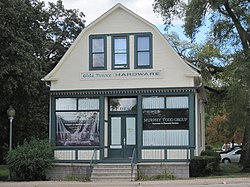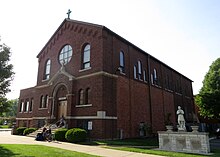Bloomingdale, Illinois
Bloomingdale | |
|---|---|
| Village of Bloomingdale | |
 | |
 Location of Bloomingdale in DuPage County, Illinois. | |
| Coordinates: 41°56′58″N 88°04′57″W / 41.94944°N 88.08250°W | |
| Country | |
| State | |
| County | DuPage |
| Township | Bloomingdale |
| Settled | 1833 |
| Incorporated | 1889 |
| Re-incorporated | June 18, 1923 |
| Founded by | Meacham Brothers (Lyman, Harvey and Silas) |
| Government | |
| • Type | Council–manager |
| • President | Franco Coladipietro |
| Area | |
• Total | 7.03 sq mi (18.20 km2) |
| • Land | 6.77 sq mi (17.52 km2) |
| • Water | 0.26 sq mi (0.68 km2) 3.69% |
| Population (2020) | |
• Total | 22,382[1] |
| • Density | 3,308.1/sq mi (1,277.28/km2) |
| Up 1.6% from 2000 | |
| Standard of living (2016-20) | |
| • Median household income | $87,397[1] |
| • Median home value | $306,400 |
| Time zone | UTC-6 (Central) |
| • Summer (DST) | UTC-5 (Central) |
| ZIP code | 60108 |
| Area codes | 630 and 331 |
| FIPS code | 17-06587 |
| Website | www |
Bloomingdale is a village in DuPage County, Illinois, United States, settled in 1833, and 25 miles northwest of downtown Chicago. The population was 22,382 at the 2020 census.
History
[edit]
Bloomingdale is one of the earliest villages settled in what is now DuPage County. The Meacham family settled here in 1833, and by the end of the following year, 12 to 15 families had settled in the locality. It was originally named Meacham's Grove.[3] The community was served by the Chicago-Galena Highway, modern day Lake Street. It became an important stop for stage coaches and westward travelers. Originally a Cook County settlement, it was annexed by DuPage County in 1839. The northern part of the village wanted to develop commercially while the southern part wished to remain a farming community. In 1923, the village split to accommodate this—the northern portion of the town was incorporated as Roselle. From 1950 to 1980, the population increased from 338 to 12,659.
The landmark U.S. Supreme Court case Illinois v. Gates began with an anonymous letter written to the Bloomingdale police department.[4]
Points of interest
[edit]Stratford Square Mall was the largest of Bloomingdale's shopping centers. The indoor mall contained two major department stores and 35 shops, plus 100 vacancies, as well as several restaurants with five vacant anchors (formerly six, yet one was demolished to make way for a Woodman's.) Also, Old Town Bloomingdale, at the intersection of Lake Street and Bloomingdale Road, is a collection of small businesses, restaurants and shops located in restored buildings at the original site of the village's first settlement.
Geography
[edit]Bloomingdale is located at 41°56′58″N 88°4′57″W / 41.94944°N 88.08250°W (41.949540, -88.082564).[5]
According to the 2021 census gazetteer files, Bloomingdale has a total area of 7.03 square miles (18.21 km2), of which 6.77 square miles (17.53 km2) (or 96.29%) is land and 0.26 square miles (0.67 km2) (or 3.71%) is water.[6]
Demographics
[edit]
| Census | Pop. | Note | %± |
|---|---|---|---|
| 1880 | 226 | — | |
| 1890 | 403 | 78.3% | |
| 1900 | 235 | −41.7% | |
| 1910 | 462 | 96.6% | |
| 1920 | 448 | −3.0% | |
| 1930 | 337 | −24.8% | |
| 1940 | 305 | −9.5% | |
| 1950 | 339 | 11.1% | |
| 1960 | 1,262 | 272.3% | |
| 1970 | 2,974 | 135.7% | |
| 1980 | 12,656 | 325.6% | |
| 1990 | 16,614 | 31.3% | |
| 2000 | 21,675 | 30.5% | |
| 2010 | 22,018 | 1.6% | |
| 2020 | 22,382 | 1.7% | |
| U.S. Decennial Census[7] | |||
As of the 2020 census[8] there were 22,382 people, 8,695 households, and 5,503 families residing in the village. The population density was 3,185.14 inhabitants per square mile (1,229.79/km2). There were 9,301 housing units at an average density of 1,323.61 per square mile (511.05/km2). The racial makeup of the village was 68.19% White, 3.64% African American, 0.48% Native American, 15.24% Asian, 0.00% Pacific Islander, 4.17% from other races, and 8.28% from two or more races. Hispanic or Latino of any race were 12.29% of the population.
There were 8,695 households, out of which 27.8% had children under the age of 18 living with them, 52.37% were married couples living together, 7.27% had a female householder with no husband present, and 36.71% were non-families. 32.50% of all households were made up of individuals, and 15.01% had someone living alone who was 65 years of age or older. The average household size was 3.12 and the average family size was 2.42.
The village's age distribution consisted of 20.3% under the age of 18, 7.1% from 18 to 24, 26.2% from 25 to 44, 24.8% from 45 to 64, and 21.6% who were 65 years of age or older. The median age was 40.9 years. For every 100 females, there were 89.8 males. For every 100 females age 18 and over, there were 88.7 males.
The median income for a household in the village was $87,397, and the median income for a family was $107,250. Males had a median income of $62,115 versus $42,861 for females. The per capita income for the village was $47,926. About 3.3% of families and 6.9% of the population were below the poverty line, including 6.2% of those under age 18 and 5.8% of those age 65 or over.
| Race / Ethnicity (NH = Non-Hispanic) | Pop 2000[9] | Pop 2010[10] | Pop 2020[11] | % 2000 | % 2010 | % 2020 |
|---|---|---|---|---|---|---|
| White alone (NH) | 17,584 | 16,216 | 14,747 | 82.37% | 73.65% | 65.89% |
| Black or African American alone (NH) | 551 | 783 | 791 | 2.54% | 3.56% | 3.53% |
| Native American or Alaska Native alone (NH) | 21 | 29 | 39 | 0.10% | 0.13% | 0.17% |
| Asian alone (NH) | 1,906 | 2,770 | 3,392 | 8.79% | 12.58% | 15.16% |
| Pacific Islander alone (NH) | 1 | 5 | 1 | 0.00% | 0.02% | 0.00% |
| Other race alone (NH) | 17 | 21 | 61 | 0.08% | 0.10% | 0.27% |
| Mixed race or Multiracial (NH) | 251 | 278 | 601 | 1.16% | 1.26% | 2.69% |
| Hispanic or Latino (any race) | 1,074 | 1,916 | 2,750 | 4.96% | 8.70% | 12.29% |
| Total | 21,675 | 22,018 | 22,382 | 100.00% | 100.00% | 100.00% |
Education
[edit]Elementary school districts serving Bloomingdale include:[12]
- Bloomingdale School District 13
- Community Consolidated School District 93
- It is headquartered in Bloomingdale and operates two schools in Bloomingdale: Stratford Middle School and the Early Childhood Center.
- Keeneyville School District 20
- Marquardt School District 15
- It operates Winnebago Elementary School in Bloomingdale.
- Medinah District 11
High school districts include:[12]
- Glenbard Township High School District 87
- Students in the section of Bloomingdale within District 87 are zoned to either Glenbard East High School in Lombard or Glenbard North High School in Carol Stream.[13][14]
- Lake Park High School (District 108) in Roselle
Bloomingdale has one private school, St. Isidore School.[12]
Nearby private schools:[12]
- St. Francis High School in Wheaton
- St. Matthew School in Glendale Heights
- St. Walter Catholic School in Roselle
- Trinity Lutheran School in Roselle
The community is served by the 35,000-square-foot (3,300 m2) Bloomingdale Public Library.[15]
Religious institutions
[edit]Religious institutions found within the village of Bloomingdale include:[16]
- Bloomingdale Church
- Bloomingdale Community Church
- Church of the Incarnation (Episcopal)
- Church of Jesus Christ of Latter Day Saints
- Cornerstone Faith Community Church
- Mission Church[17]
- Shree Radhey Shyam Temple
- St. Andrew's Ukrainian Orthodox Church
- St. Isidore's Roman Catholic Church
- World Mission Society Church of God
Transportation
[edit]Pace provides bus service on Routes 711 and 715 connecting Bloomingdale to Wheaton and other destinations.[18]
Notable people
[edit]- Nate Fox, professional basketball player[19]
- Frank C. Rathje, president of the American Bankers Association, founder of the Mutual National Bank of Chicago
References
[edit]- ^ a b c "QuickFacts Bloomingdale village, Illinois". U.S. Census. Retrieved September 4, 2022.
- ^ "2020 U.S. Gazetteer Files". United States Census Bureau. Retrieved March 15, 2022.
- ^ "Several Towns Named After Founders and Heroes". The Daily Herald. December 28, 1999. p. 220. Retrieved August 17, 2014 – via Newspapers.com.

- ^ Illinois v. Gates, 462 U.S. 213 (1983).
- ^ "US Gazetteer files: 2010, 2000, and 1990". United States Census Bureau. February 12, 2011. Retrieved April 23, 2011.
- ^ Bureau, US Census. "Gazetteer Files". Census.gov. Retrieved June 29, 2022.
{{cite web}}:|last=has generic name (help) - ^ "Census of Population and Housing". Census.gov. Retrieved June 4, 2015.
- ^ "Explore Census Data". data.census.gov. Retrieved June 28, 2022.
- ^ "P004 Hispanic or Latino, and Not Hispanic or Latino by Race – 2000: DEC Summary File 1 – Bloomingdale village, Illinois". United States Census Bureau.
- ^ "P2 Hispanic or Latino, and Not Hispanic or Latino by Race – 2010: DEC Redistricting Data (PL 94-171) – Bloomingdale village, Illinois". United States Census Bureau.
- ^ "P2 Hispanic or Latino, and Not Hispanic or Latino by Race – 2020: DEC Redistricting Data (PL 94-171) – Bloomingdale village, Illinois". United States Census Bureau.
- ^ a b c d "Bloomingdale Area Schools." Village of Bloomingdale, Illinois. Retrieved on June 20, 2017. See: School district map which indicates elementary school and high school districts
- ^ "Boundary Map Archived 2016-03-22 at the Wayback Machine." Glenbard Township High School District 87. Retrieved on June 20, 2017.
- ^ "Zoning." Village of Bloomingdale, Illinois. Retrieved on June 20, 2017. Shows the exact village boundaries.
- ^ "Bloomingdale Public Library." Village of Bloomingdale, Illinois. Retrieved on June 20, 2017.
- ^ "Churches | Bloomingdale, IL - Official Website". www.villageofbloomingdale.org. Retrieved August 14, 2020.
- ^ "Mission Church". Mission Church. Retrieved August 14, 2020.
- ^ "RTA System Map" (PDF). Retrieved January 30, 2024.
- ^ Fornek, Kimberly (August 25, 2017). "Hinsdale businessman sentenced to 70 years in murder of supposed romantic rival". Chicago Tribune. Retrieved December 10, 2017.




